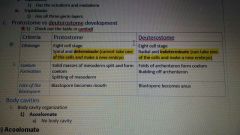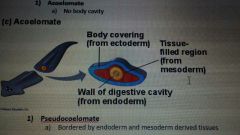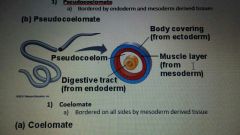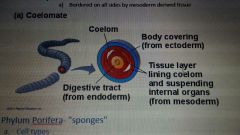![]()
![]()
![]()
Use LEFT and RIGHT arrow keys to navigate between flashcards;
Use UP and DOWN arrow keys to flip the card;
H to show hint;
A reads text to speech;
33 Cards in this Set
- Front
- Back
|
Animal nutrition
|
Chemo - heterotrophic
Feed by ingestion |
|
|
Cell structure/ specialization
|
Complex body system with tissues
Multicellularity via colonial body plan Single cell-colonial-true Multicellularity |
|
|
Reproduction and development
|
Life cycle is dilploid dominant
Sexual reproduction dominant Embryo to gastrula |
|
|
Early development in animals
|
Zygote- eight cell stage- blastula- formation of blastocoel- gastrulation- gastrula
|
|
|
Choanoflagellates
|
Protists ancestor to animals
|
|
|
Evolutionary history
|
Multicellularity due to predation
Link to sponges (collar cell looks like choanoglagellates) |
|
|
First animal
|
750 mya
|
|
|
Ediacarian biota
|
600 mya
|
|
|
Cambrian explosion
|
540 mya
|
|
|
Animals on land
|
450 mya
|
|
|
Conserved trait
|
Shared trait among many animals
Gastrulation |
|
|
Nonconserved trait
|
Trait that varies between animal
|
|
|
Germ layers
|
Ectoderm- skin
Endoderm- many of internal organs Mesoderm- skeletal, muscle systems |
|
|
Diploblastic
|
Endoderm and ectoderm
|
|
|
Triploblastic
|
Ectoderm, endoderm, mesoderm
|
|
|
Protosome vs deuterostome
|

|
|
|
Acoelomate
|

No body cavity
|
|
|
Pseudocoelomate
|

Bordered by endoderm and mesoderm derived tissue
|
|
|
Coelomate
|

Bordered on all sides by mesoderm derived tissue
|
|
|
Proifera
|
Phylum
Classes: calcarea, hexatinellida, demospongia No true tissue No gastrulation Coanocyte: filter feeders that look like choanoflagellates |
|
|
Proifera body plans
|
Ascnoid- thin walls and large spongeal
Syconoid- thickening the walls and smaller spongea Leuconoid- mostly walls and very little to no spongoceal |
|
|
Ascnoid
|
Thin walls large spongoceal
|
|
|
Syconoid
|
Thicker walls smaller spongoceal
|
|
|
Leuconoid
|
Mostly walls and very little if no spongeal
|
|
|
Calcarea
|
Proifera
Phylum proifera Calcium carbonate spiracles 2-4 points Straight or rays |
|
|
Hexatinellida
|
Proifera
SiO2 glass Multiples of 6 |
|
|
Demospongia
|
Proifera
SiO3 glass Less than 6 95% of living sponges All are leuconoid |
|
|
Cnidaria
|
Phylum
Class: hydrozoa, scyphozoa, cubozoa, anthozoa Life cycle alternates between polyp and Medusa True tissue Diploblastic GVC Carnivores Radial symmetry |
|
|
Hydrozoa
|
Cnidaria
Polyp dominant Colonial but specialized (reproductive, feeder polyps) Man of war |
|
|
Scyphozoa
|
Cnidaria
The jellyfish Medusa dominant Somewhat specialized |
|
|
Cubozoa
|
Cnidaria
Different venom than scyphozoa Box jelly Bell is more box shaped |
|
|
Anthozoa
|
Cnidaria
Corals and anemones Polyp dominant |
|
|
Ctenophora
|
Comb jelly
Have keep rows with cilia |

